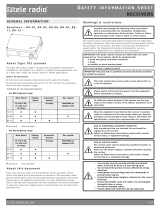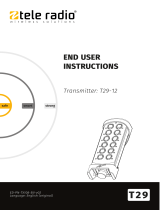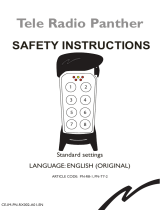Page is loading ...

safe smart strong
T19
ED-PN-TX103-EN-v04
Language: English (original)
ENDUSER
INSTRUCTIONS
Transmitter: T19-02

©Tele Radio AB
Datavägen 21
SE-436 32 Askim
Sweden
Phone: +46 (0)31 748 54 60

CHAPTER 1: INTRODUCTION 4
1.1About this document 6
1.2About T19 transmitters 7
CHAPTER 2: SAFETY 8
2.1Warnings & restrictions 8
2.2Safety features 11
CHAPTER 3: TECHNICAL DATA 12
3.1Transmitter specifications 12
3.2Radio frequency band 13
CHAPTER 4: PRODUCT GENERAL DESCRIPTION 14
4.1Transmitter front 14
4.2Transmitter back 15
4.3Top LED status indication 15
CHAPTER 5: ERROR INDICATIONS AND CODE MESSAGES 16
CHAPTER 6: OPERATION 17
6.1General information 17
6.2Radio mode 18
6.3Functionality test 19
6.4Start a session 20
6.5Log the transmitter out from a receiver 21
6.6Switch the transmitter off 22
CHAPTER 7: BATTERY 23
7.1Battery precautions 23
7.2Battery information 25
CHAPTER 8: FOILS 27
8.1Affix a foil to the transmitter 27
CHAPTER 9: WARRANTY, SERVICE, REPAIRS, AND MAINTENANCE 28
CHAPTER 10: REGULATORY INFORMATION 29
10.1Europe 29
10.2North America 30
10.3Brazil 32
10.4AEC 32
ANNEX A: INDEX 33
ED-PN-TX103-EN-v04 3

CHAPTER 1: INTRODUCTION
Thank you for using a Tele Radio AB product
READ ALL INSTRUCTIONS AND WARNINGS CAREFULLY BEFORE OPERATING
THE PRODUCTS.
These Enduser instructions have been published by Tele Radio AB and are not
subject to any guarantees. The Enduser instructions may be withdrawn or revised
by Tele Radio AB at any time and without further notice. Corrections and updates
will be added to the latest version of the manual. Always download the Enduser
instructions from our website, www.tele-radio.com, for the latest available version.
Keep the safety instructions for future reference.
IMPORTANT! These instructions are intended for end users. The instructions can be
printed and handed to end user.
Tele Radio AB remote controls are often built into wider applications. This
documentation is not intended to replace the determination of suitability or
reliability of the product for specific user applications and should not be used for
this purpose. It is the responsibility of any such users or integrators to perform the
appropriate and complete risk analysis, evaluation and testing of the products with
respect to the relevant specific application or use. Tele Radio AB shall not be
responsible or liable for misuse of the information contained herein.
Always refer to the applicable local regulations for installation and safety
requirements relating to cranes, hoists, material handling applications, lifting
equipment, industrial machinery, and/or mobile hydraulic applications using Tele
Radio AB products, e.g.:
lapplicable local and industrial standards and requirements,
lapplicable occupational health and safety regulations,
lapplicable safety rules and procedures for the factory where the equipment is
being used,
luser and safety manuals or instructions of the manufacturer of the
equipment where Tele Radio AB remote control systems are installed.
Tele Radio AB Enduser instructions do not include or address the specific
instructions and safety warnings of the end product manufacturer.
For battery precautions, see "7.1 Battery precautions".
4 ED-PN-TX103-EN-v04

1.1About this document
Before installing or operating the product, read the corresponding documentation
carefully.
Tele Radio AB's product range is composed of transmitters, receivers, and
accessories intended for use together as a system.
These Enduser instructions cover general safety issues, main technical
specifications, standard operating instructions and battery information. Images
shown in this document are for illustrative purposes only.
Please report any error or omission in this document, as well as any improvement
or amendment suggestion to td@tele-radio.com.
1.1.1COPYRIGHT
Information in this document is subject to change without notice. No part of this
publication may be reproduced, stored in a retrieval system, or transmitted in any
form or by any means, electronic, photographic, mechanical (including
photocopying), recording or otherwise for any purpose other than the purchaser's
personal use without the written permission of Tele Radio AB.
1.1.2TERM AND SYMBOL DEFINITIONS
The capitalized terms and symbol used herein shall have the following meaning:
lWARNING: indicates a hazardous situation which, if not avoided, could result
in death or serious injury.
lCAUTION: indicates a hazardous situation which, if not avoided, will result in
minor or moderate injury.
lIMPORTANT: is used for information that requires special consideration.
lNOTE: is used to address practices not related to physical injury.
This symbol is used to call attention to safety messages that would be
assigned the signal words "WARNING"or "CAUTION".
6 ED-PN-TX103-EN-v04

1.2About T19 transmitters
Tele Radio AB's remote control systems are suitable for a wide variety of
applications for e.g. stationary or mobile equipments, hydraulic machines,
construction, forestry or agriculture equipments and more. Tele Radio AB's
transmitters and receivers are highly customizable and can be configured to suit
the most wide-ranging application requirements & usage habits.
T19 transmitters have simplex communication and work in either discontinuous or
continuous mode.
ED-PN-TX103-EN-v04 7

CHAPTER 2: SAFETY
2.1Warnings & restrictions
Carefully read through the following safety instructions before
proceeding with the installation, configuration, operation, or
maintenance of the product. Failure to follow these warnings could
result in death or serious injury.
This product must not be operated without having read and understood the
Enduser instructions and having received the appropriate training. The purchaser
of this product has been instructed how to handle the system safely. The following
information is intended for use as a complement to applicable local regulations
and standards.
IMPORTANT! Tele Radio AB remote controls are often built into wider
applications. These systems should be equipped with:
• a wired emergency stop where necessary
• a brake
• an audible or visual warning signal
2.1.1OPERATION
This radio system must not be used in areas where there is a risk of
explosion.
Only qualified personnel should be permitted to access the transmitter
and operate the equipment.
The user should:
8 ED-PN-TX103-EN-v04

lAlways follow operating and maintenance instructions as well as all
applicable safety procedures and requirements.
lDo not open the receiver encapsulation unless you are qualified.
lYou must satisfy the age requirements in your country for operating
the equipment.
lIt is strictly prohibited to operate the equipment under the influence
of drugs, alcohol and/or medications.
lAlways test the transmitter stop button before operating it. Press the
stop button then twist and pull it out. This test should be done on
each shift, without a load.
lNever use a transmitter if the stop button is mechanically
damaged.Contact your supervisor or representative for service
immediately.
lNever leave the transmitter unattended.
lAlways switch the transmitter off when not in use. Store in a safe
place.
lKeep a clear view of the work area at all times.
2.1.2MAINTENANCE
Before maintenance intervention on any remote controlled equipments:
• always remove all electrical power from the equipment.
• always follow lockout procedures.
lKeep the safety information for future reference. Always download the
Enduser instructions from our website, www.tele-radio.com, for the latest
available version.
lIf error messages are shown, it is very important to find out what caused
them. Contact your representative for help.
lThe functionality of the stop button should be tested at least after every 200
hours’ use.
lIf the stop button is mechanically damaged, do not use the transmitter.
Contact your supervisor or representative for service immediately.
lKeep the product in a clean, dry place.
lDo not try to open the encapsulation.
ED-PN-TX103-EN-v04 9

lAlways contact your representative for service and maintenance work on the
product.
lKeep contacts and antennas clean.
lWipe off dust using a clean, slightly damp cloth.
lNever use cleaning solutions.
lCheck the encapsulation, foils and cable for damages every day. If you use
the product although the encapsulation or foil is damaged, moisture can
cause serious damage to the electronics.
10 ED-PN-TX103-EN-v04

2.2Safety features
2.2.1STOP BUTTON
IMPORTANT! The Stop button should always be tested before operating the
transmitter. This test should be done on each shift, without a load.
To test the stop button:
1. Press the Stop button.
2. Twist and release the Stop button.
ED-PN-TX103-EN-v04 11

CHAPTER 3: TECHNICAL DATA
3.1Transmitter specifications
Number of buttons 8 x 2-step buttons
Power supply 3 x 1.5V AAA / LR03 in battery pack D4-3
I/O switch No
Radio communication Simplex
Radio frequency band 2405 – 2480 MHz
Number of channels 16 (channel 11–26)
Radio frequency output
power
EIRP1 < 10dBm (10 mW)
Operating time
(continuous usage)
Approximately 100 h with alkaline (depending on
settings)
IP code IP65
Operating temperature -20…+55 °C / -4…+130 °F
Charging temperature +10…+35 °C (+50…+95°F)
Safety levels EN ISO13849-1,PLd CAT3 (Stop function)
Dimensions 85 x 193 x 43 mm / 3.4 x 7.7 x 1.7 in
Weight 300 g / 0.7 lbs
1Equivalent isotropic radiated power
12 ED-PN-TX103-EN-v04

3.2Radio frequency band
For radio systems operating on frequency band 2.4 GHz, the frequency band is
divided into 16 channels (11 to 26). Once the channel has been selected on the
transmitter, the receiver will automatically detect and switch to the same channel.
Channel Frequency (MHz) Channel Frequency (MHz)
11 2405 19 2445
12 2410 20 2450
13 2415 21 2455
14 2420 22 2460
15 2425 23 2465
16 2430 24 2470
17 2435 25 2475
18 2440 26 2480
ED-PN-TX103-EN-v04 13

CHAPTER 4: PRODUCT GENERAL DESCRIPTION
The pictures shown in this chapter are for illustrative purposes only.
4.1Transmitter front
1. Rubber cover
2. Stop button
3. LED 1 (red)
4. LED 2 (red)
5. LED 3 (red)
6. LED 4 (red)
7. Top LED (red, green)
8. Button 1
9. Button 2
10. Button 3
11. Button 4
12. Button 5
13. Button 6
14. Button 7 – Left Start
button
15. Button 8 – Right
Start button
4.1.1SHIFT BUTTON
In some cases, the right Start button1 is used as a shift button to access some
menus and/or channels.
To activate the shift function, press the shift button and keep it pressed. Press the
button corresponding to the desired channel/ menu. Release it, then release the
shift button.
1T19-2: button 8.
14 ED-PN-TX103-EN-v04

4.2Transmitter back
1. Rubber cover
2. Stop button
3. Battery/Battery
pack
4. Replace IDlabel (under the rubber cover)
5. Product label (inside the battery compartment)
6. FCC/IClabel (under the rubber cover)
4.3Top LED status indication
The top LED is a multicolored LED that lights or flashes green when the battery
capacity is good and red when the battery capacity is poor. When the top LED
lights/flashes red, battery should be charged or changed at the next convenient
opportunity (see "7.2.1 Change the batteries in battery pack D4-3 ").
ED-PN-TX103-EN-v04 15

CHAPTER 5: ERROR INDICATIONS AND CODE
MESSAGES
Each error is identified by a code indicated by a LED combination including the top
LED (LED0) and LEDs 1–4.
: LED is lit (red). : LED is off
: LED is blinking green/red.
NOTE: The following error indications apply for models with SW version 18 or
higher.
LED0
green/red
LED1
red
LED2
red
LED3
red
LED4
red
Indicates
Production data error
Radio initialization has failed
Stop button test is required
CPU2 will power off the radio module
Stop button memory error
Flow control error
16 ED-PN-TX103-EN-v04

CHAPTER 6: OPERATION
6.1General information
6.1.1RECEIVERS WITH LOGIN/LOGOUT1 FUNCTION ACTIVATED
To control a receiver, the transmitter must be registered and logged in to the
receiver. If another transmitter is already logged in to the receiver, it must be
logged out before a different transmitter can be logged in.
If no transmitter is logged in to the receiver, the first registered transmitter to be
started will automatically log in to the receiver. Once a transmitter has been logged
in, it will remain logged in until it is manually logged out.
More than one transmitter can be registered in the receiver, but only one
transmitter can be logged in at a time.
NOTE: For the logout function to work, BOTH the receiver and the transmitter
must have the logout function activated and be set to continuous radio mode.
6.1.2RECEIVERS WITHOUT LOGIN/LOGOUT FUNCTION OR WITH
LOGIN/LOGOUT FUNCTION INACTIVATED
To control a receiver, the transmitter must be registered in the receiver.
If no transmitter is controlling the receiver, the first registered transmitter to be
started will automatically take control of the receiver. Switching the transmitter off
will free the receiver and allow any other registered transmitter that is started to
control the receiver.
More than one transmitter can be registered in the receiver, but only one
transmitter can control the receiver at a time.
6.1.3MULTIPLE TRANSMITTERS REGISTERED IN A SAME
RECEIVER
If more than one transmitter is registered in the same receiver, it is recommended
to select the same frequency channel on all transmitters.
1For more information about login/logout, see the transmitter installation instruction
ED-PN-TX103-EN-v04 17

6.2Radio mode
NOTE: To establish a radio link between the transmitter and the receiver, both
units must be set to the same radio mode.
This transmitter is set to continuous radio mode by default. The transmitter starts
to transmit continuously as soon as it is started. The radio transmission ends when
the stop button is pressed. When the system is in continuous radio mode, buttons
7 and 8 are used as start buttons.
NOTE: Some functions are only available when the products are transmitting
continuously. Those functions are marked: "Only for continuous radio mode" in
the manual.
18 ED-PN-TX103-EN-v04

6.3Functionality test
NOTE: This list is intended for use as a support for the manufacturer of the
equipment where Tele Radio AB remote control systems are installed.
Before operating the radio system, follow the procedure below.
IMPORTANT! This test should be performed at each shift, without a load, and
should include but not be limited to the following steps
lMake sure that the controlled object can not cause any harm in the event of
unexpected movement.
lAlways follow local safety rules and start the equipment according to the
corresponding instructions.
lMake sure that the transmitter can control the receiver by testing all
functions.
lMake sure that the functions respond as expected.
lMake sure that all movements are as planned.
lMake sure that the stop button works correctly.
lMake sure that the stop function works correctly.
lMake sure the system stops when the batteries are removed from the
transmitter.
ED-PN-TX103-EN-v04 19

6.4Start a session
To be able to control a receiver with the transmitter, the transmitter must be
registered in the receiver.
When starting the transmitter, it will automatically log in to the receiver(s) it has
been registered in, provided that no other transmitter is already logged in to the
receiver(s). If the transmitter was not logged out after the last session, it will
remain logged in when starting a new session.
When not in use, transmitters must be switched off and stored in a
secure storage space.
Do not use the system if the stop button is damaged or if it does not
stop the equipment. Doing so could result in serious injury or death.
1. Make sure that the Stop button is pressed.
2. Twist and release the Stop button.
The top LED lights. LEDs 3 and 4 flash (red).
3. Press buttons 7 and 8 simultaneously for at least 1 second.
LEDs 3 and 4 light (red).
4. Release buttons 7 and 8.
LEDs 3 and 4 go out. The top LED flashes.
5. Proceed with the functional test (see "6.3 Functionality test").
20 ED-PN-TX103-EN-v04
/














